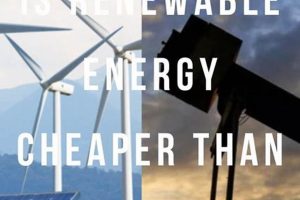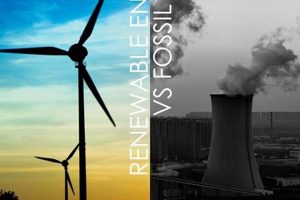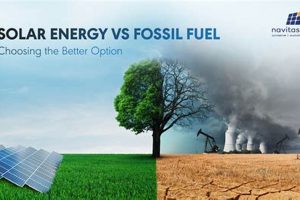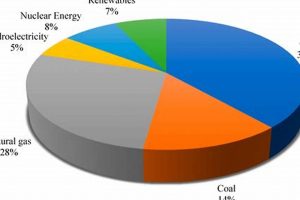Examining the distinctions between energy derived from ancient organic matter and that generated from replenishable sources illuminates critical choices for future energy production. This involves analyzing attributes like environmental impact, cost, availability, reliability, and scalability of each energy type. For example, one might contrast the carbon emissions of coal with the emissions-free operation of solar panels or the steady output of a nuclear power plant with the intermittent nature of wind energy.
Understanding the diverse energy landscape empowers informed decisions regarding resource allocation, policy development, and technological advancements. Historically, societies have relied heavily on readily available fossil fuels. However, growing concerns about climate change, resource depletion, and energy security have shifted the focus towards sustainable alternatives. This shift necessitates thorough evaluations of the strengths and weaknesses of each energy source to facilitate a responsible transition towards a more sustainable energy future.
This exploration delves into the nuances of both non-renewable and renewable energy sources, providing a foundation for informed discussion and analysis. Topics covered will include the environmental and economic ramifications of continued fossil fuel dependence, the potential and challenges of transitioning to a renewable energy-dominant system, and the role of technological innovation in shaping the future energy landscape.
Tips for Evaluating Energy Sources
Careful consideration of various factors is crucial for objective assessment of energy options. The following tips offer guidance for navigating the complexities of energy choices.
Tip 1: Consider the Full Life Cycle: Evaluation should encompass the entire energy production process, from resource extraction and processing to transportation, utilization, and waste disposal. For example, while nuclear power plants produce minimal operational emissions, the mining and processing of uranium ore have environmental consequences.
Tip 2: Account for Geographic Factors: Resource availability and suitability vary geographically. Solar energy is more effective in regions with abundant sunlight, while wind energy thrives in areas with consistent wind patterns. Local conditions significantly influence the viability of specific energy sources.
Tip 3: Evaluate Scalability and Infrastructure: Transitioning to a new energy source requires assessing its potential for large-scale deployment and the necessary infrastructure. Does the existing grid infrastructure support integration of intermittent renewable sources like solar and wind?
Tip 4: Factor in Economic Implications: Analyze the economic costs and benefits of each energy source, including initial investment, operational expenses, job creation potential, and impact on energy prices.
Tip 5: Assess Environmental Impact: Quantify the environmental footprint of each energy source, considering greenhouse gas emissions, air and water pollution, land use changes, and potential impacts on ecosystems.
Tip 6: Consider Technological Advancements: The energy landscape is constantly evolving. Stay informed about emerging technologies and their potential to improve the efficiency, affordability, and sustainability of various energy sources.
Tip 7: Prioritize Energy Security: Evaluate the reliability and resilience of different energy sources, considering factors like fuel availability, geopolitical stability, and susceptibility to natural disasters or disruptions.
By carefully considering these factors, a more comprehensive understanding of the energy landscape can be achieved, facilitating informed decision-making and promoting a sustainable energy future.
These tips provide a framework for navigating the complex considerations involved in energy choices. The subsequent sections will further explore specific aspects of each energy type in greater detail.
1. Environmental Impact
A central consideration in evaluating energy sources is their environmental impact. Comparing fossil fuels and renewable energy options requires a thorough assessment of their respective effects on air and water quality, land use, ecosystems, and the global climate. This analysis is crucial for informed decision-making and the development of sustainable energy strategies.
- Greenhouse Gas Emissions
Fossil fuel combustion releases substantial amounts of greenhouse gases, primarily carbon dioxide, contributing significantly to climate change. Renewable energy sources, such as solar and wind, generate electricity without direct greenhouse gas emissions, offering a pathway towards mitigating climate change impacts. This difference in emissions profiles is a key factor in comparing energy sources.
- Air and Water Pollution
Burning fossil fuels releases pollutants like sulfur dioxide and nitrogen oxides, contributing to acid rain and respiratory problems. Coal mining can also contaminate water sources. Renewable energy sources generally have a lower impact on air and water quality, though manufacturing processes and land use changes associated with some renewable technologies can present localized environmental challenges. Understanding these trade-offs is crucial for a balanced comparison.
- Land Use and Ecosystem Disruption
Fossil fuel extraction, including coal mining and oil drilling, can significantly alter landscapes and disrupt ecosystems. Renewable energy technologies also require land use for infrastructure such as solar farms and wind turbines, but their overall land use impact is often lower than that of fossil fuels. Evaluating the ecological footprint of both energy types is essential for a comprehensive comparison.
- Waste Disposal and Management
Fossil fuel combustion generates ash and other byproducts that require careful disposal. Nuclear power produces radioactive waste that needs long-term storage. While renewable energy sources generally produce less waste, the disposal of components like solar panels and wind turbine blades requires consideration. Analyzing waste management strategies for each energy type informs the overall environmental impact assessment.
These facets of environmental impact underscore the complex considerations involved in comparing fossil fuels and renewable energy sources. A transition towards cleaner energy requires a holistic evaluation of both the immediate and long-term environmental consequences of different energy choices, paving the way for a more sustainable energy future.
2. Cost Comparison
Cost comparison forms a critical component when evaluating fossil fuels against renewable energy sources. This analysis encompasses not only the initial capital expenditures for power plant construction but also ongoing operational and maintenance costs, fuel expenses (where applicable), and the potential costs associated with environmental externalities, such as pollution or climate change mitigation. For example, while the upfront cost of building a solar photovoltaic (PV) plant can be substantial, the ongoing fuel costs are effectively zero, unlike a coal-fired power plant, which requires continuous coal purchases. Additionally, factoring in the social cost of carbon emissions can significantly shift the economic balance in favor of renewable options.
Analyzing levelized cost of electricity (LCOE) provides a standardized metric for comparing different energy sources over their lifetime. LCOE calculations incorporate all relevant costs, including capital costs, fuel costs, operating and maintenance expenses, and financing costs, and express them as a single value per unit of electricity generated (typically $/MWh). Examining historical LCOE trends reveals a dramatic decline in the cost of renewable energy technologies, particularly solar and wind, making them increasingly competitive with fossil fuels, even without considering the external costs of pollution.
Understanding cost dynamics is crucial for informing investment decisions, policy development, and the overall transition towards a sustainable energy future. While fossil fuels have historically benefited from established infrastructure and economies of scale, the declining costs of renewable energy technologies, coupled with growing concerns about environmental externalities, are shifting the economic landscape of energy production. Accurate cost comparisons are essential for making informed choices that balance economic viability, environmental sustainability, and energy security.
3. Resource Availability
Resource availability plays a crucial role in evaluating the long-term viability of different energy sources. Comparing fossil fuels and renewable energy necessitates a thorough understanding of the abundance, accessibility, and distribution of the resources required for each energy type. This analysis informs decisions regarding energy security, infrastructure development, and the potential for sustained energy production.
- Fossil Fuel Depletion
Fossil fuels are finite resources formed over millions of years. Their extraction and consumption rates are significantly outpacing their natural replenishment. Depletion of these resources raises concerns about future energy security, price volatility, and the need for alternative energy sources. For example, declining oil reserves in some regions have led to increased exploration in more challenging and environmentally sensitive areas.
- Renewable Resource Abundance
Renewable energy sources, such as solar, wind, hydro, and geothermal, are virtually inexhaustible. Sunlight, wind, water flow, and geothermal heat are continuously replenished by natural processes. This inherent abundance offers a significant advantage over fossil fuels, providing long-term energy security and reducing dependence on finite resources. For instance, solar energy potential vastly exceeds current global energy demand, highlighting the opportunity for widespread adoption.
- Geographic Distribution of Resources
The geographic distribution of energy resources significantly influences their accessibility and economic viability. Fossil fuel reserves are concentrated in specific regions, leading to geopolitical considerations and potential supply disruptions. Renewable resources, while generally more widely distributed, exhibit regional variations. Solar energy is more abundant in sunny regions, while wind energy potential is higher in areas with consistent wind patterns. Understanding these geographic variations is crucial for optimizing resource utilization and infrastructure development. For example, countries with limited fossil fuel reserves may prioritize developing their renewable energy potential.
- Resource Intermittency and Storage
Many renewable energy sources, such as solar and wind, are intermittent, meaning their output fluctuates depending on weather conditions. This intermittency requires strategies for managing energy storage and grid stability. Pumped hydro storage, batteries, and other storage technologies are essential for balancing supply and demand and ensuring a reliable energy supply from intermittent renewable sources. This aspect of resource availability is a key consideration in integrating renewable energy into existing power grids.
These facets of resource availability underscore the critical distinctions between fossil fuels and renewable energy sources. The finite nature of fossil fuels and their uneven distribution necessitate a transition towards more sustainable and widely accessible renewable energy options. Analyzing resource availability, along with technological advancements and economic considerations, informs the development of effective energy policies and promotes a secure and sustainable energy future.
4. Technological Maturity
Technological maturity plays a crucial role in the comparison of fossil fuels and renewable energy sources. It influences the efficiency, cost-effectiveness, reliability, and scalability of each energy technology. A mature technology typically benefits from optimized processes, established supply chains, and a skilled workforce. This analysis of technological maturity provides insights into the current state and future potential of different energy options.
- Research and Development
Continuous research and development efforts drive innovation and improve the performance of energy technologies. Fossil fuel technologies have benefited from decades of research, resulting in highly efficient combustion engines and power plants. However, significant investments are now directed towards advancing renewable energy technologies, such as more efficient solar cells, advanced wind turbine designs, and improved energy storage solutions. The pace of innovation in renewable energy is rapid, leading to continuous improvements in efficiency and cost competitiveness.
- Infrastructure and Deployment
Existing infrastructure significantly influences the ease of deployment for different energy technologies. Fossil fuels benefit from a well-established infrastructure for extraction, processing, transportation, and utilization. Developing the necessary infrastructure for renewable energy integration, such as grid modernization and energy storage facilities, requires significant investment. However, the declining costs of renewable energy technologies and supportive government policies are driving rapid infrastructure development, facilitating wider adoption of renewable energy sources.
- Operational Efficiency and Reliability
Operational efficiency and reliability are critical factors for evaluating energy technologies. Mature fossil fuel technologies generally exhibit high operational efficiency and reliability. However, renewable energy technologies are rapidly catching up. Modern wind turbines and solar PV systems demonstrate high levels of efficiency and reliability, while advancements in energy storage technologies are addressing the intermittency challenges associated with renewable sources. These improvements contribute to the increasing competitiveness of renewable energy in the global energy market.
- Scalability and Manufacturing Capacity
Scalability refers to the ability of a technology to be deployed on a large scale to meet growing energy demands. Fossil fuel technologies are readily scalable, but their environmental impact limits their long-term viability. Renewable energy technologies, particularly solar and wind, exhibit high scalability potential. Manufacturing capacity for renewable energy components, such as solar panels and wind turbine blades, is rapidly expanding, further supporting their widespread deployment. This scalability is crucial for meeting global energy demand while mitigating climate change impacts.
The comparison of fossil fuels and renewable energy sources through the lens of technological maturity reveals a dynamic landscape. While fossil fuels have historically benefited from mature technologies and established infrastructure, renewable energy technologies are rapidly advancing, becoming increasingly efficient, reliable, and cost-competitive. Continued investments in research, development, and infrastructure will further accelerate the transition towards a sustainable energy future powered by renewable resources.
5. Energy Security
Energy security is a critical dimension in the evaluation of energy sources, encompassing the reliable availability of energy at affordable prices. Comparing fossil fuels and renewable energy through the lens of energy security requires assessing factors such as resource accessibility, supply chain vulnerabilities, geopolitical implications, and the potential for disruptions. This analysis is essential for informing national energy policies and ensuring stable and sustainable energy supplies.
- Resource Dependence and Geopolitics
Reliance on fossil fuels often entails dependence on imports from politically volatile regions, creating vulnerabilities to supply disruptions and price fluctuations. Diversifying energy sources through the adoption of domestically sourced renewable energy can enhance energy independence and reduce geopolitical risks. For example, nations heavily reliant on imported natural gas might invest in domestic wind or solar power to reduce their vulnerability to international price shocks or supply disruptions.
- Supply Chain Vulnerability
Fossil fuel supply chains, encompassing extraction, processing, and transportation, can be susceptible to disruptions caused by natural disasters, geopolitical events, or technical failures. Renewable energy sources, particularly distributed generation like rooftop solar, offer greater resilience against widespread disruptions. A localized power outage, for instance, might have less impact on homes equipped with solar panels and battery storage compared to those solely reliant on the grid.
- Price Volatility and Affordability
Fossil fuel prices are subject to fluctuations influenced by global market dynamics, geopolitical tensions, and resource scarcity. Renewable energy sources, once the initial investment is recovered, offer stable and predictable energy costs, as their fuel (sunlight, wind, etc.) is essentially free. This price stability can protect consumers and businesses from the volatility of fossil fuel markets, contributing to greater economic stability. For example, widespread adoption of solar power can insulate electricity prices from fluctuations in the global natural gas market.
- Infrastructure Resilience and Grid Stability
Investing in resilient energy infrastructure is crucial for maintaining energy security. Renewable energy sources, when integrated strategically with grid modernization efforts, can enhance grid stability and resilience. For instance, distributed generation from rooftop solar can reduce reliance on centralized power plants and transmission lines, minimizing the impact of localized outages. Furthermore, incorporating advanced grid management technologies and energy storage solutions can effectively address the intermittency of renewable sources, ensuring a reliable and stable energy supply.
Comparing fossil fuels and renewable energy from an energy security perspective reveals crucial trade-offs. While fossil fuels offer established infrastructure and readily available resources, they present vulnerabilities related to resource dependence, price volatility, and geopolitical instability. Renewable energy sources, on the other hand, offer greater potential for long-term energy security, price stability, and enhanced grid resilience, contributing to a more sustainable and secure energy future. As renewable energy technologies continue to mature and become more cost-competitive, they play an increasingly important role in strengthening national energy security and mitigating the risks associated with fossil fuel dependence.
Frequently Asked Questions
This section addresses common inquiries regarding the distinctions between non-renewable and renewable energy sources, offering concise and informative responses to facilitate a deeper understanding of the energy landscape.
Question 1: How significantly do fossil fuels contribute to global greenhouse gas emissions?
Fossil fuel combustion accounts for the majority of global greenhouse gas emissions, primarily carbon dioxide, driving climate change and its associated impacts. The precise contribution varies annually but remains the dominant source.
Question 2: Can renewable energy sources realistically meet global energy demand?
The global potential of renewable energy sources, particularly solar and wind, significantly surpasses current and projected energy demands. Realizing this potential requires substantial investments in infrastructure, technology development, and grid modernization.
Question 3: What are the primary economic barriers to widespread renewable energy adoption?
Upfront capital costs for renewable energy technologies can be significant, although declining rapidly. Additional economic challenges include integrating intermittent renewable sources into existing power grids and developing adequate energy storage solutions.
Question 4: How does the environmental impact of fossil fuel extraction compare to that of renewable energy development?
Fossil fuel extraction, including mining and drilling, often entails significant environmental disruption, including habitat destruction, water contamination, and greenhouse gas emissions. While renewable energy development can have localized environmental impacts, the overall footprint is generally smaller than fossil fuel extraction.
Question 5: What role does energy storage play in the transition to a renewable energy future?
Energy storage is crucial for addressing the intermittency of renewable sources like solar and wind. Effective storage solutions, such as batteries and pumped hydro, enable a consistent and reliable energy supply from variable renewable resources.
Question 6: How can government policies incentivize the development and adoption of renewable energy technologies?
Government policies can play a vital role in accelerating the transition to renewable energy. Incentives such as tax credits, feed-in tariffs, renewable portfolio standards, and carbon pricing mechanisms can stimulate investment in and deployment of renewable energy technologies.
Understanding the nuances of energy choices requires addressing common misconceptions and concerns. Informed decision-making relies on access to accurate and unbiased information regarding the benefits and challenges associated with each energy source.
The following sections will delve further into specific aspects of fossil fuels and renewable energy, providing a more granular analysis of their respective characteristics and contributions to the global energy landscape.
Comparison of Fossil Fuels and Renewable Energy
The examination of contrasting energy sources reveals a critical juncture in global energy production. Fossil fuels, while offering established infrastructure and readily available resources, present substantial and escalating environmental challenges, particularly concerning climate change. Renewable energy sources, despite requiring significant infrastructure development and technological advancements, offer a pathway towards a more sustainable energy future, characterized by reduced emissions, enhanced energy security, and long-term resource availability. This comparative analysis underscores the need for a strategic transition away from fossil fuel dependence and towards a diversified energy portfolio centered on renewable resources.
The future of energy hinges on informed decisions, strategic investments, and a global commitment to sustainability. Accelerating the development and deployment of renewable energy technologies, coupled with policies that incentivize their adoption and address the challenges of integration, is essential for mitigating the risks of climate change and ensuring a secure and sustainable energy future for generations to come. The transition represents not merely a technological shift, but a fundamental reshaping of the global energy landscape, demanding careful consideration of economic, environmental, and geopolitical factors.







